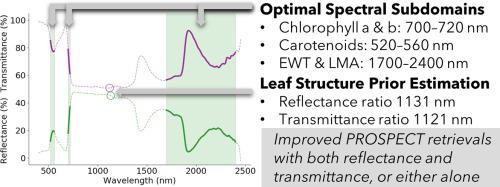当前位置:
X-MOL 学术
›
Remote Sens. Environ.
›
论文详情
Our official English website, www.x-mol.net, welcomes your
feedback! (Note: you will need to create a separate account there.)
Spectral subdomains and prior estimation of leaf structure improves PROSPECT inversion on reflectance or transmittance alone
Remote Sensing of Environment ( IF 11.1 ) Pub Date : 2021-01-01 , DOI: 10.1016/j.rse.2020.112176 Lynsay Spafford , Guerric le Maire , Andrew MacDougall , Florian de Boissieu , Jean-Baptiste Féret
Remote Sensing of Environment ( IF 11.1 ) Pub Date : 2021-01-01 , DOI: 10.1016/j.rse.2020.112176 Lynsay Spafford , Guerric le Maire , Andrew MacDougall , Florian de Boissieu , Jean-Baptiste Féret

|
Abstract Leaf biochemical and structural traits are vegetation characteristics related to various physiological processes. Taking advantage of the physical relationship between optical properties and leaf biochemistry, field-based spectroscopy has allowed for the rapid estimation of leaf biochemical constituents and repeated non-destructive measurements through time. Leaf constituent retrieval from leaf optical properties following inversion of the physically-based radiative transfer model PROSPECT is now a popular method, but some cases prompt poor retrieval success and this approach requires a strict inversion procedure. We investigated the performances of different inversion procedures for the estimation of leaf constituents, specifically chlorophyll a and b, carotenoids, water (EWT), and dry matter (LMA) from >1400 broadleaf samples, including the definition of optimal spectral subdomains, and the use of leaf reflectance or transmittance alone. We also developed a strategy to obtain prior information on the leaf structure parameter (N) in PROSPECT, when only reflectance or transmittance is measured, and examined the influence of this prior information in combination with different inversion procedures. We found that using the full domain of reflectance or transmittance only systematically leads to suboptimal estimation of chlorophyll a and b, carotenoids, EWT, and LMA, due to either the combined absorption of multiple constituents or inaccurate estimation of the N parameter. Our study confirms that the selection of optimal spectral subdomains leads to improved estimation of all leaf constituents, from 700 to 720 nm for chlorophyll a and b, 520–560 nm for carotenoids, and from 1700 to 2400 nm for EWT and LMA. Prior information on N, computed directly from the spectra, leads to systematic improved estimation of leaf constituents when only reflectance or transmittance is measured, with reductions in normalized root mean square error from 8 to 37%. We strongly recommend using optimal subdomains when inverting PROSPECT to retrieve leaf constituents, and with the availability of only reflectance or transmittance we further recommend the use of prior information on the N parameter.
中文翻译:

光谱子域和叶片结构的先验估计可单独改进反射率或透射率的 PROSPECT 反演
摘要 叶片生化和结构性状是与各种生理过程相关的植被特征。利用光学特性和叶子生物化学之间的物理关系,基于现场的光谱学允许快速估计叶子生化成分和随时间重复的非破坏性测量。在基于物理的辐射传输模型 PROSPECT 反演之后,从叶子光学特性中检索叶子成分现在是一种流行的方法,但在某些情况下,检索成功率很低,这种方法需要严格的反演程序。我们研究了不同反演程序用于估计叶片成分的性能,特别是叶绿素 a 和 b、类胡萝卜素、水 (EWT) 和来自 > 1400 个阔叶样品的干物质 (LMA),包括最佳光谱子域的定义,以及单独使用叶子反射率或透射率。当仅测量反射率或透射率时,我们还开发了一种获取有关 PROSPECT 中叶片结构参数 (N) 的先验信息的策略,并结合不同的反演程序检查了此先验信息的影响。我们发现,由于多种成分的组合吸收或 N 参数的不准确估计,使用反射率或透射率的完整域只会系统地导致对叶绿素 a 和 b、类胡萝卜素、EWT 和 LMA 的次优估计。我们的研究证实,最佳光谱子域的选择可以改进对所有叶片成分的估计,叶绿素 a 和 b 的波长从 700 到 720 nm,类胡萝卜素的波长为 520–560 nm,对于 EWT 和 LMA,从 1700 到 2400 nm。直接从光谱计算的 N 的先验信息导致在仅测量反射率或透射率时系统改进对叶片成分的估计,归一化均方根误差从 8% 减少到 37%。我们强烈建议在反转 PROSPECT 以检索叶成分时使用最佳子域,并且在仅提供反射率或透射率的情况下,我们进一步建议使用 N 参数的先验信息。
更新日期:2021-01-01
中文翻译:

光谱子域和叶片结构的先验估计可单独改进反射率或透射率的 PROSPECT 反演
摘要 叶片生化和结构性状是与各种生理过程相关的植被特征。利用光学特性和叶子生物化学之间的物理关系,基于现场的光谱学允许快速估计叶子生化成分和随时间重复的非破坏性测量。在基于物理的辐射传输模型 PROSPECT 反演之后,从叶子光学特性中检索叶子成分现在是一种流行的方法,但在某些情况下,检索成功率很低,这种方法需要严格的反演程序。我们研究了不同反演程序用于估计叶片成分的性能,特别是叶绿素 a 和 b、类胡萝卜素、水 (EWT) 和来自 > 1400 个阔叶样品的干物质 (LMA),包括最佳光谱子域的定义,以及单独使用叶子反射率或透射率。当仅测量反射率或透射率时,我们还开发了一种获取有关 PROSPECT 中叶片结构参数 (N) 的先验信息的策略,并结合不同的反演程序检查了此先验信息的影响。我们发现,由于多种成分的组合吸收或 N 参数的不准确估计,使用反射率或透射率的完整域只会系统地导致对叶绿素 a 和 b、类胡萝卜素、EWT 和 LMA 的次优估计。我们的研究证实,最佳光谱子域的选择可以改进对所有叶片成分的估计,叶绿素 a 和 b 的波长从 700 到 720 nm,类胡萝卜素的波长为 520–560 nm,对于 EWT 和 LMA,从 1700 到 2400 nm。直接从光谱计算的 N 的先验信息导致在仅测量反射率或透射率时系统改进对叶片成分的估计,归一化均方根误差从 8% 减少到 37%。我们强烈建议在反转 PROSPECT 以检索叶成分时使用最佳子域,并且在仅提供反射率或透射率的情况下,我们进一步建议使用 N 参数的先验信息。











































 京公网安备 11010802027423号
京公网安备 11010802027423号